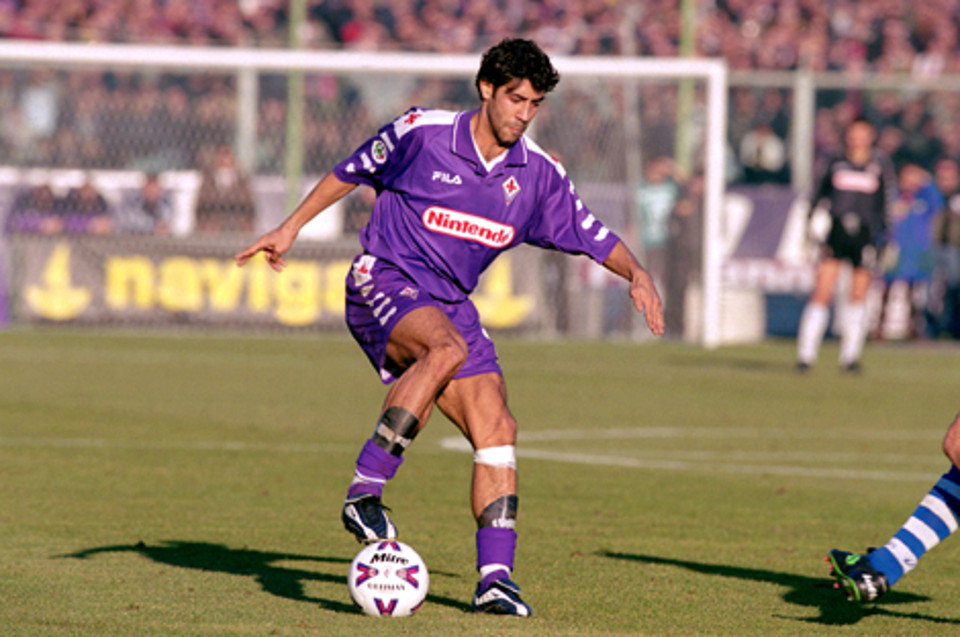We used to say: “This guy, Le Tissier, is outrageous and he never goes to a big team. He stays at Southampton. It’s incredible. He could play for anyone.”
Words uttered by Xavi, a serial winner of trophies at both club and international level, about a player who didn’t win a thing. Their medal haul may be different but the two men share a common bond which transcends any trophy: their love for the ball and an overriding belief that it should be played their way, on their terms.
Matthew Le Tissier, the lifelong Saint, saviour and miracle-worker enjoyed entertaining his congregation at The Dell on a weekly basis. So often did he conjure the miraculous, he was christened ‘Le God’ by Southampton’s adoring fans. One may be excused for believing his blessed technique and ability to be simply divine, but that would be doing Le Tissier – a player accused as being lazy throughout his career – a disservice. As Dave Merrington, his former youth team coach at Southampton explained:
When people say he was lazy…no! Matt wasn’t lazy, he loved the game as much as I did and would work at the game; as long as he had a football.
Le Tissier’s incredible skill wasn’t all natural talent. As a child growing up in Guernsey he wanted nothing more than to become a professional footballer, so practiced with a ball as much as he could. A patch of grass not far from the family home served as a pitch for impromptu 8-a-side matches with his three older brothers and their friends. Pretending to be his idol, Spurs legend Glenn Hoddle, playing against the older kids helped his progress.
If nobody was available to play, his imagination invented drills. Using a tennis ball to throw high against the side of his house, he would take it on his chest and then volley against a neighbours’ shed to score. The shed was split into three partitions so the youngster would aim for left and right sides, as middle was where goalkeeper would be (of course!).
Years later, fans of the Premier League would witness the fruits of his labour as the scorer of countless, almost poetic goals. Despite classing himself as a midfielder, Le Tissier was the archetypal trequartista – then still a foreign concept in the UK and definitely at odds with England’s football culture and the majority of coaches. So although a classic No.10, he wore the No.7 shirt, more in line with the UK culture of deep-lying forwards, made famous by the likes of Kenny Dalglish and Peter Beardsley at Liverpool and Eric Cantona of Manchester United, who’d all played similar roles in their teams: the attacking fulcrum charged with both creating and scoring, whilst blessed with having unrivalled flair and technique.
Whilst Le Tissier confirms he probably assisted just as many goals as he scored (161 in the top-flight) during his career, it is almost certainly his goals for which he became worldly famous for.
Goals to rival anything seen on the continent during that time – a place where he didn’t go unnoticed. Particularly in Catalonia where the Xavi household, obsessed by his scoring feats, would marvel at the Saints star. The Barcelona legend admitting years later:
There used to be a half-hour programme every Monday where they’d show the best goals from the Premier League. Every week, Matt Le Tissier would be on the show. I’m talking outrageous, sickening goals. Straight in the top corner, left-foot flick and then right over a defender and score against Newcastle.
His talent was out of the norm. He could dribble past seven or eight players but without speed – he just walked past them. For me he was sensational. He was definitely an idol.
Our whole house was obsessed with him.
The famous couple of goals against Newcastle United which announced Le Tissier to the wider world in 1993 almost never come to pass. Untrusted by manager Ian Branfoot, a former defender who, as Lawrie McMenemy put it, “paid more attention to Matty’s weaknesses [physical attributes] rather than his strengths [technical abilities]“, he was either played on the wing or dropped. However his two spectacular strikes in that 2-1 win were the turning point of his career – he wouldn’t be dropped for the next 5 years.
The goals – particularly his first – are stuff of legend by now but, somewhat surprisingly, are not the player’s own favourite because of the execution of his finish – catching it with the underside of his boot instead of a fully caressed side-foot meant it bobbled into the net.
“I would have preferred it to have been a crisper finish, as a perfectionist,” Le Tissier later said…because the gloss had been taken off the actual act of flicking the ball from behind himself, then juggling it past two opponents first! Complaining about this goal is like complaining about finding a dirty, winning lottery ticket.
Still, the great playmaker did credit his first touch for the goal with the hours of practice he’d put in as a kid. Oh and the not too shabby second goal was placed exactly where he planned – although he admits to being too shattered to celebrate it.
Teams are seldom built around one man; particularly perennial strugglers and especially in England if that man is seen as being nonchalant and lacking in competitive spirit. But that’s exactly what Southampton did under new coach Alan Ball, instructing the team that:
This is your best player and your best chance of getting out of trouble. I’m going to put him right in the middle of the pitch and whenever you get the chance, get the ball to his feet. He will do the rest.
Le Tissier repaid his coach as captain and inspirational leader by producing the best goalscoring form of his career, and enjoyed being the ‘go-to’ man of the team. During this period the Saints star scored what he chose as the best of his career – the 40 yard curler against Blackburn Rovers. Why did he chose it? Because “from a technical point of view it was perfect. The ball went exactly where I wanted it to go, and was a shot I’d practiced quite a lot in training.”
The subject of practicing to score the divine has risen again. Surely nobody who knew Le Tissier could accuse him of simply coasting along during his career, taking his natural talent for granted.
He just loved playing with the ball too much.
Another special goal against Aston Villa in 1994 portrayed innate talent to the watching masses at the time, but years later Le Tissier revealed the real secret to the goal. Controlling a long, high clearance out of the air whilst running through on goal – killing the ball dead with his first touch – and rounding the keeper to score, he reflected afterwards.
He realised that he used to practice that move as a boy over and over again: on an empty pitch around 35-yards from goal, on the run, he would blast ball up in the air as high as possible and attempt to control on the drop then finish, to improve his first-touch. He was delighted thinking back to that moment and making the link.
At Southampton, former teammates recall countless occasions when the midfielder would remain for extra training, completing shooting and free-kick drills, and “hitting 50 or so a day”.
The spectacular goals continued to come thick and fast during the next few seasons, and are too numerous to mention, let alone do justice to the individual beauty with mere words. Highlights include a goal at Anfield which had the Kop applauding after turning centre-back Mark Wright inside out, a unique flick-up and volleyed free-kick against Wimbledon (again, a previously practiced drill), and a cheeky 20-yard chip over Peter Schmeichel during a 6-3 victory over Manchester United. This particular goal showed his acute awareness of the game, and of his opponents.
Having seen Newcastle United defender Philippe Albert score a chip over his opponent a week earlier, Le Tissier noticed that the keeper liked to stand off his goal line. Outside the penalty box having dribbled around two United defenders, the Southampton fantasista surmised where Schmeichel would likely be and executed a sand-wedge finish without looking.
As with most fantasisti, Le Tissier was charged with taking penalties – a duty he embraced. Scoring 47 out of 48 in his career, he approached them with confidence and saw them logically for what they were: the easiest chance he’d get to score in a game.
Today, footballers get lambasted for showing a lack of loyalty to their clubs, so it’s somewhat ironic that Le Tissier got (and continues to get) questioned for remaining at Southampton his entire career. Did it hurt his international ambitions? Maybe, but there’s more to it than that, particularly when Glenn Hoddle was the coach.
It’s a travesty that Le Tissier didn’t win more England caps, having made just 8 senior appearances, and never in a major tournament, when the likes of ‘workman-like’ midfielder Carlton Palmer won 18 over a similar period – something which Le Tissier questioned in his autobiography. Palmer was within his rights to publically return fire over the slur on Sky’s Soccer AM TV show by again questioning his ambition and desire, however Le Tissier remained 1-up with this classic Twitter response:
So, ive been getting stick on soccer am by the only footballer i knew who could control a ball further than he could kick it
— Matt Le Tissier (@mattletiss7) April 2, 2016
The one thing Le Tissier had always wanted after making it as a professional was to play for England. He even wrote a story in school about playing for England, against Germany, with his childhood idol Glenn Hoddle. Little did he know at the time but old adage warning never to meet your hero proved true years later.
He could never quite understand why there was a certain animosity shown towards him by Hoddle. Le Tissier now believes the most likely explanation was Hoddle’s dislike of the constant comparisons being made between the two. Le Tissier also admitted to refusing Hoddle’s request for him to see controversial faith healer Eileen Drewery, having been called up for England duty.
Things came to a head when, having scored a hat-trick for England B before the World Cup ’98 squad announcement, the Southampton star was left off the initial 30-man list for the tournament in France, famously, only finding out he hadn’t made it via Teletext. Other players had at least been given the courtesy of a phone call. He would never play for England again.
It was the other turning point of his career, one that started a downward trajectory. Le Tissier later admitted he never recovered from the World Cup blow and his club form deteriorated as a consequence. His main childhood ambition – as depicted through his school story – had been taken away and, along with injuries, took its toll over the next few seasons.
‘Ambition’ is a subjective word when discussing Le Tissier. As mentioned, it was, and is still, routinely used in a negative context towards him, with the former playmaker jokingly admitting he only hears it after the preceding words of “lack of”. A quick look at the synonyms for ‘ambition’ gives the following: goal, aim, objective, aspiration, dream. The young Le Tissier had two lifetime ambitions; he’d achieved both by his mid-twenties. His dream wasn’t to win any league titles or cups, but to be a professional player, to represent his country and to enjoy his football. The Saints man hits back the lack of ambition accusation as sweetly as any of his picturebook strikes: “Have you achieved your lifetime ambitions by the age of 25?”
He’s content with his career, and why shouldn’t he be? 100 goals scored in the Premier League era, thus becoming the first midfielder to reach that milestone, he thrived on being the big fish in a small pond, and doesn’t believe he would enjoy the game today with the added showbiz fame and increased media glare off the pitch.
It was truly fitting that the final goal scored at The Dell in 2001 – a typical, almost scripted, swivel and volley in last minute to win the match 3-2 against Arsenal – was to be scored by the man voted in 2012 as the club’s greatest ever player. So it is also fitting to imagine, and perhaps believe that somewhere in time, echoing for eternity, is The Dell as it was, celebrating that final goal indefinitely as the name “Le Tissier!” rings out. After all, his spectacular goals, and the joy he brought to his worshipping fans, transcends any trophy.









